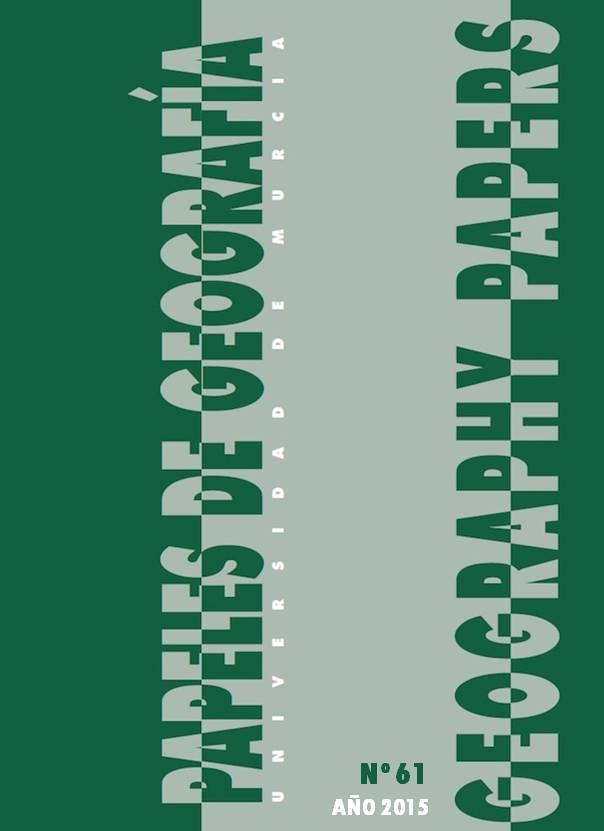The mountain range of Cartagena-La Union (Murcia): an example of tourist activity through the mining heritage
Supporting Agencies
- Universidad Nacional de Educación a Distancia. Departamento de Geografía.
Abstract
The final cessation in 1991 of mining in the Sierra de Cartagena-La Union Murcia region earned it the beginning of a major economic downturn has not answered until recent times, where the initiative for the enhancement of important mining-industrial legacy is now the basis for the creation of a tourism project complementary to traditional sun and beach located in La Manga del Mar Menor. The SWOT analysis included as the main methodology of this work will allow through the participation of different groups understand and analyze the present and the future prospects of this new activity that potentially represent a major change in the socio-economic activity of the region and therefore of its inhabitants.
Downloads
References
ADEPA.http://www.adepa-patrimonio.org/index.php/temas-de-patrimonio histórico/patrimonio-minero [consulta: 15-01-2015].
ANDRÉS SARASA, J. L.(1998) “¿Cuencas mineras en crisis versus destinos turísti-cos?” Papeles de Geografía, nº 27, pp. 5-14.
ANTOLINOS MARÍN, J.A. y PEÑAS CASTEJÓN, JOSÉ MATÍAS (2007) “Catalogación del patrimonio cultural en la sierra minera de Cartagena-La Unión”, pp. 327-416
BELL ADELL, C. (1982) Población y Recursos humanos de la Región de Murcia. Biblioteca básica murciana, nº 12.
BENITO DEL POZO, P. (2002): “Patrimonio industrial y cultura del territorio”, Boletín de la Asociación de Geó¬grafos Españoles, nº 34, pp. 213-227.
CAÑIZARES RUIZ, M.C. (2011) “Patrimonio, parques mineros y turismo en España” Cuadernos de Turismo, nº 27; pp. 133-153.
CAÑIZARES RUIZ, M.C. (2011): “Protección y defensa del patrimonio Minero en España”, Scripta Nova, Vol. XV, nº 361, en http://www.ub.es/geocrit/sn/sn-361.htm [consulta: 11-04-2014].
CARCELÉN GONZÁLEZ., R (2013) “Proyecto de recuperación del arsenal de Cartagena”. Incuna. Gijón (Asturias) pp. 715-722
CASANELLES, E y FERNÁNDEZ, M. (1994) “Un modelo para trabajar el patrimonio industrial”, en El Patrimonio Histórico artístico. Barcelona. Graó Educación.
CASTAÑEDA LÓPEZ, C (2013) “Iniciativas de recuperación en el patrimonio minero y regeneración medioambiental”. Incuna. Gijón (Asturias). pp. 375-381
CONSEJERÍA DE TURISMO Y ORDENACIÓN DEL TERRITORIO DE LA REGIÓN DE MURCIA (2004) Plan de dinamización turística de la Sierra Minera de La Unión-Cartagena. Documento de síntesis. 16 pp.
http://www.murciaturistica.es/PORTAL2002/sectorturistico/pdf/Final%20sierra%20minera%20la%20union-cartagena.pdf [consulta: 15-01-2015]
(2009) Atlas de los paisajes de la Región de Murcia. Murcia, 234 páginas.
CONSEJERÍA DE TURISMO Y ORDENACIÓN DEL TERRITORIO DE LA REGIÓN DE MURCIA (2004) Plan de dinamización turística de la Sierra Minera de La Unión-Cartagena. Documento de síntesis. 16 pp.
http://www.murciaturistica.es/PORTAL2002/sectorturistico/pdf/Final%20sierra%20minera%20la%20union-cartagena.pdf [consulta 15-01-2015]
CONSEJERÍA DE OBRAS PÚBLICAS Y ORDENACIÓN DEL TERRITORIO (2009) Atlas de los paisajes de la Región de Murcia. Murcia. 234 pp.
GARCÍA DELGADO, F.J. y Otros (2013) “El turismo en la cuenca minera de Ríotinto” Cuadernos de Turismo, nº 31; pp. 129-152.
GIL OLCINA, A. “Evolución demográfica del municipio minero de La Unión” en dialnet.unirioja.es/descarga/articulo/2296099.pdf [consulta 10-03-2015]
HUDSON, K. (1983) The archaeology of the consumer society: the second industrial revolution in Britain. Londres. Heinemann
LLURDÉS I COIT, J.C. (1994) “El turismo industrial y la estética de los paisajes en declive”. Estudios Turísticos, n.° 121. pp. 91-107.
LLURDÉS I COIT, J.C. (1997) “El turismo de patrimonio industrial y minero. Una experiencia de turismo interior inexplorada en estado español” Ediciones de la UAM.
LLURDÉS I COIT, J.C. (1999) “Patrimonio industrial y patrimonio de la humanidad. El ejemplo de las colonias textiles catalanas. Potencialidades turísticas y algunas reflexiones. Boletín de la AGE, nº 28, pp. 155-176.
MARTÍNEZ, A. y PÉREZ, D. (1998) “El patrimonio industrial de la provincia de Alicante. Rehabilitación y nuevos usos”. Investigaciones geográficas, nº 19, pp. 49-66.
MORALES YAGO, F.J (2013). “El impacto de la actividad turística sobre el paisaje de La Manga del Mar Menor (Murcia)”. Estudios Geográficos, nº 57, pp.523-556.
PARDO ABAD, C.J. (2008): Turismo y patrimonio industrial. Madrid, Síntesis.
PARDO ABAD, C.J. (2010): “El patrimonio industrial en España: análisis turístico y significado territorial de algunos proyectos de recuperación”, Boletín de la Asociación de Geó¬grafos Españoles, nº 53, pp. 239-264.
PARDO ABAD, C.J. (2011): Paisajes industriales e industrias para el turismo: simbolismo patrimonial y alcance territorial. Rotur Revista Ocio y Turismo, nº 4, pp. 15-32.
PRAT I FORGA, J.M. (2014) “La generación de capital social alrededor del turismo industrial en destinos de Cataluña y Escocia”. Geographos. Vol. 5 nº 58. pp. 47-69 (http://web.ua.es/revista-geographos-giecryal) [consulta 11-03-2015]
VALENZUELA RUBIO, M y Otros (2008) “La valorización turística del patrimonio minero en entornos rurales desfavorecidos. Actores y experiencias”. Cuadernos de Turismo, nº 22; pp. 231-260.
The manuscripts published in Papeles de Geografía are subject to the following terms and conditions:
1. The publishing house of the University of Murcia (Servicio de Publicaciones de la Universidad de Murcia) keeps the copyright of the published manuscripts favouring and allowing the use and distribution of such works under the licence in 2 below.
© Servicio de Publicaciones, Universidad de Murcia, 2011
2. Manuscripts are published electronically under an Attribution Non-Commercial No Derivatives 3.0 Unported Creative Commons Licence Spain (Legal text). Readers are free to copy, use, share and redistribute the material in any medium or format as long as (i) appropriate credit is given to authors and original source (journal, publishing house and URL); (ii) the material is not used for commercial purposes and (iii) this licence and restrictions are stated.
3. Self-archive. Authors are allowed and encouraged to distribute pre-print versions (prior to evaluation) and/or post-print versions (after evaluation and accepted for publication) of their manuscripts. This favours the dissemination and early distribution of scientific knowledge and citing.






